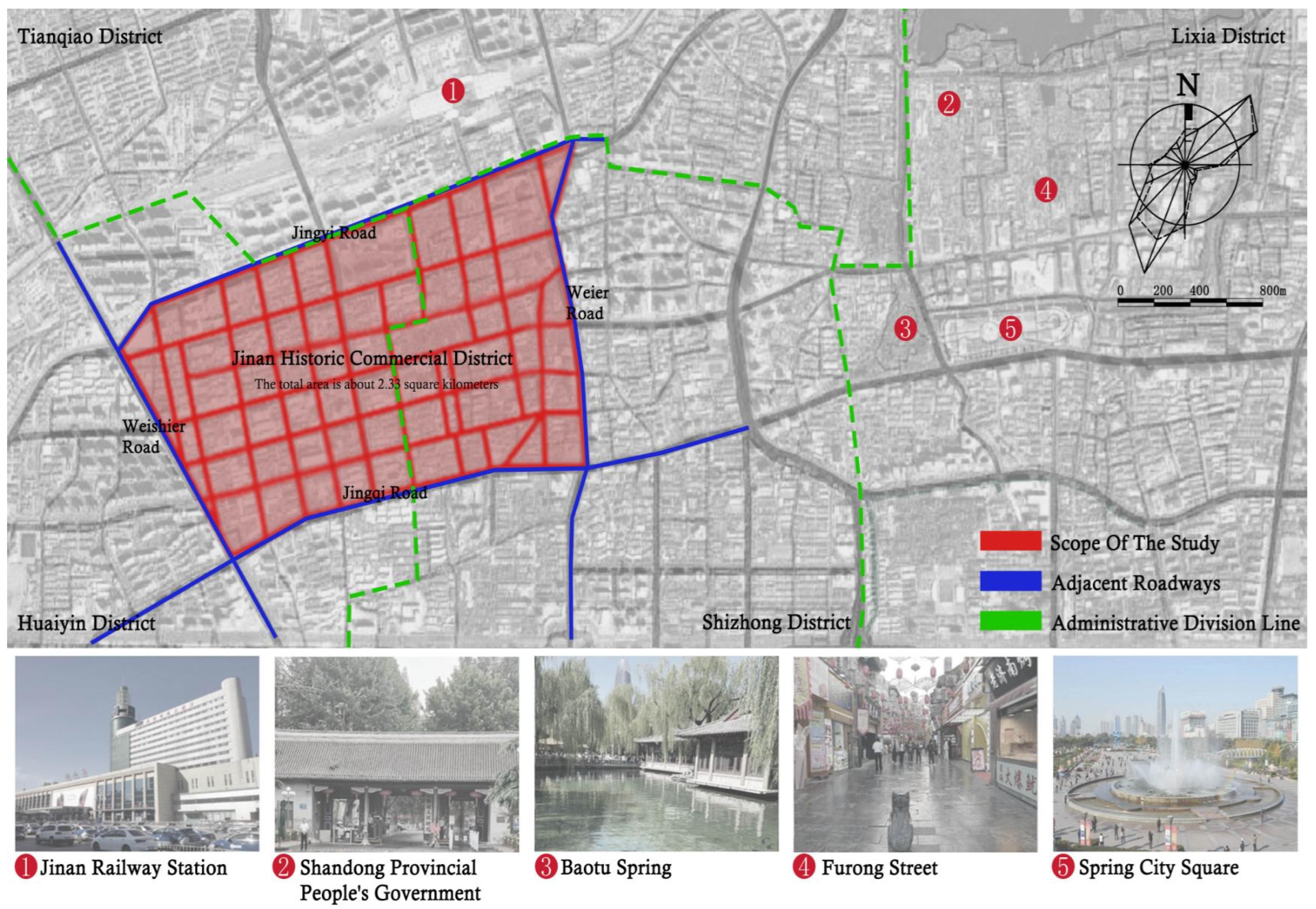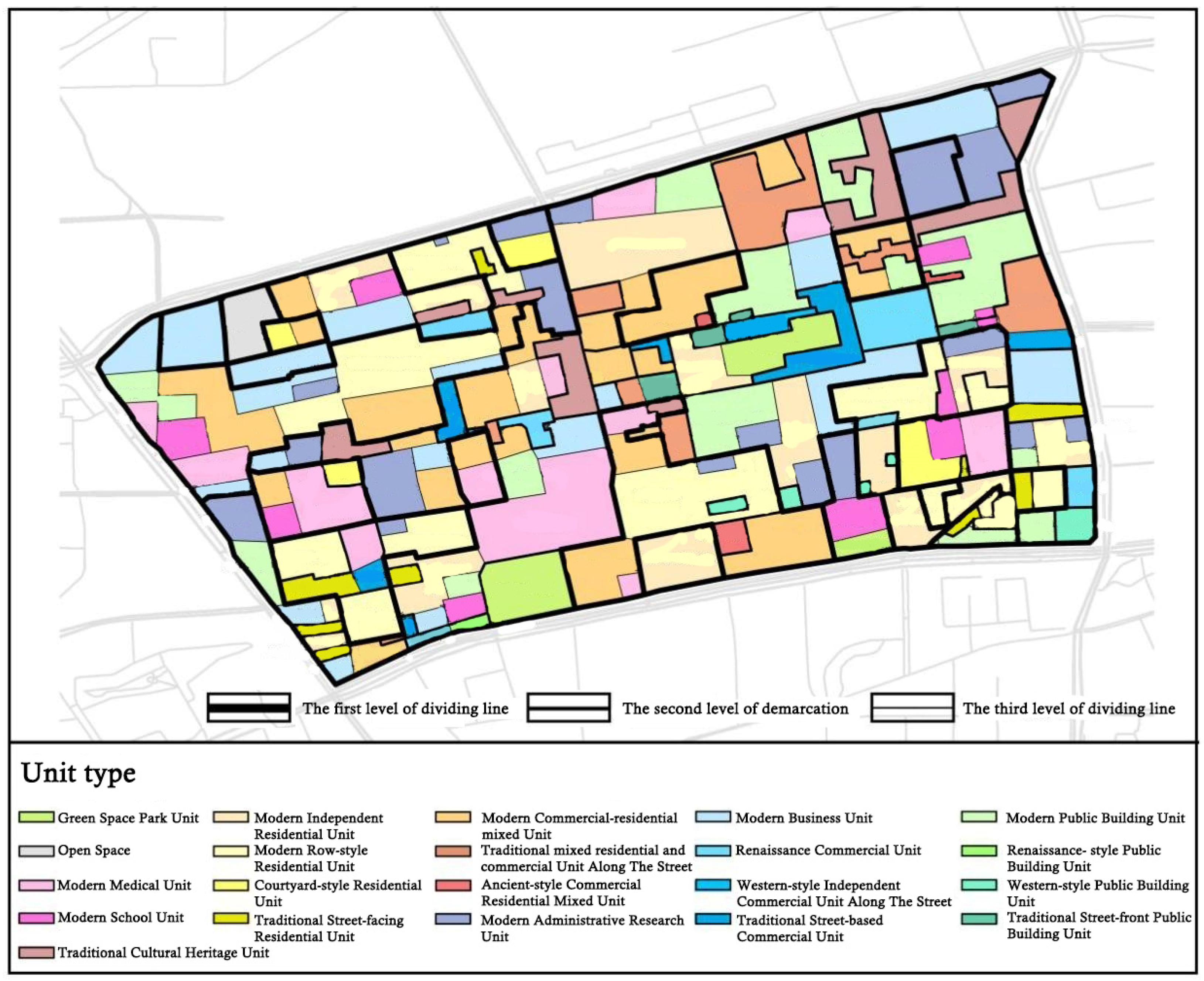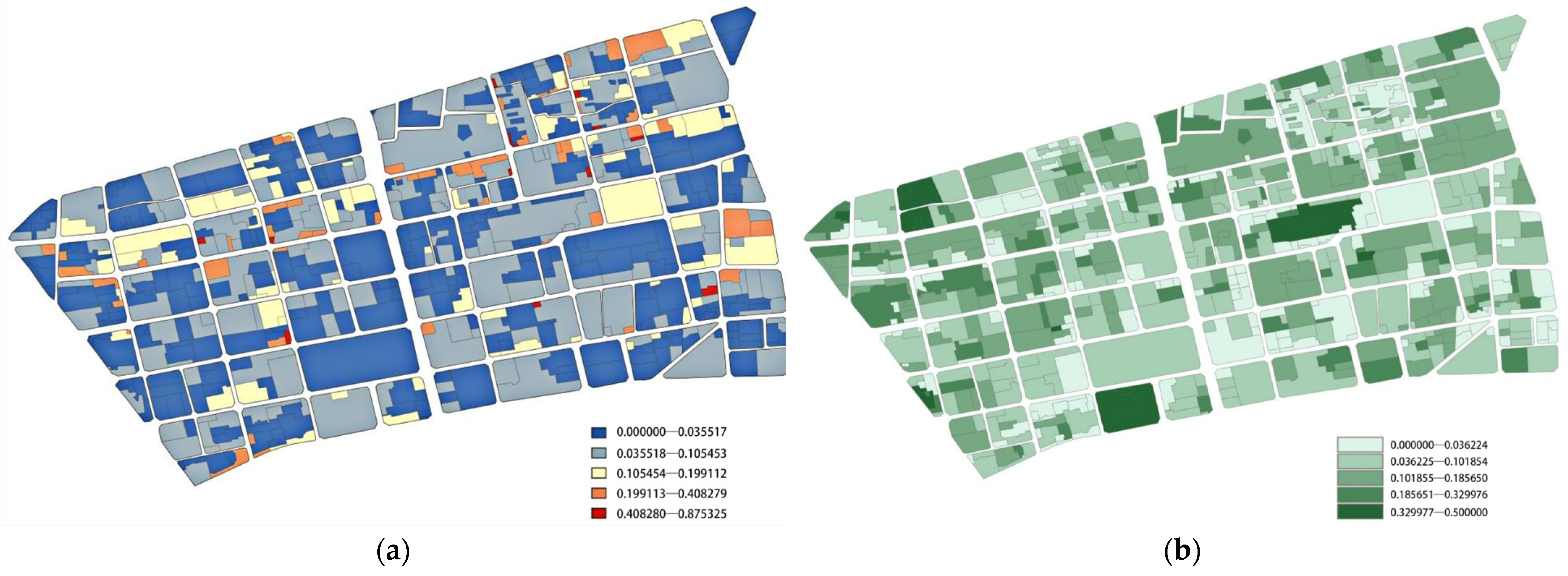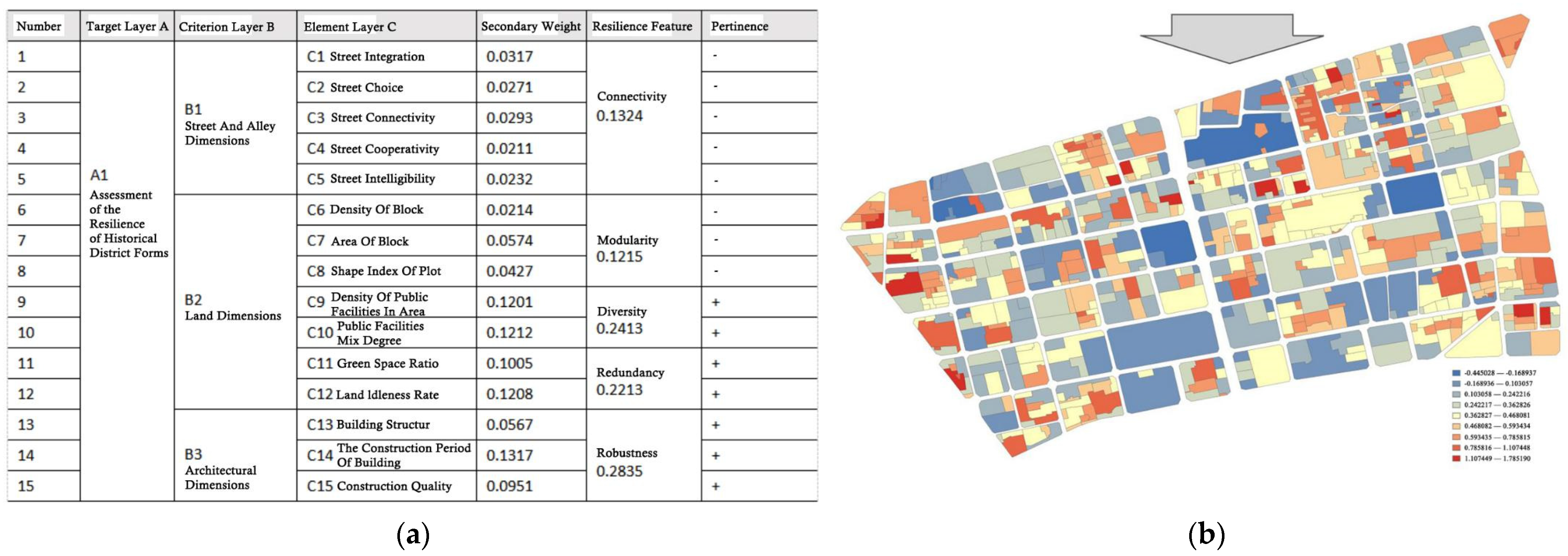Research on Morphological Resilience and Assessment Methodology in Historic Districts: A Case Study of Jinan Historic Commercial District
Abstract
1. Introduction
1.1. Limitations of Traditional Expansion Planning and Risk Management in Building Resilience
1.2. Research Gaps in Morphological Resilience of Historic Districts at Meso-Micro Scales
1.3. Feasibility of Assessing Morphological Resilience in Historic Districts
1.4. International Case Comparison and Global Perspectives
2. Development of a Morphological Resilience Assessment Framework for Historic Districts
2.1. Delineation of Morphological Regions
2.2. Selection of Resilience Indicators
2.3. Establishing Conceptual Mapping
2.4. Sensitivity and Robustness Analysis of the Assessment Framework
2.5. Consideration of Temporal Dynamics
3. Case Selection for Morphological Resilience Implementation in Historic Districts
3.1. Research Subject
3.2. Morphological Zoning of the Commercial District
3.3. Quantitative Resilience Analysis of the Commercial District
- (1)
- Street Network Dimension
- (2)
- Land Dimension
- (3)
- Architectural Dimension
- (4)
- Comprehensive Morphological Resilience
3.4. Morphological Resilience Zones in the Concession Area
3.5. Sensitivity of Research Results to Spatial Resolution
3.6. Positioning the Results Within Global Research Paradigms
4. Strategies for Morphological Resilience Conservation and Renewal in Historic Districts
4.1. High-Resilience Preservation Units
4.2. Medium-Resilience Enhancement Units
4.3. Low-Resilience Redevelopment Units
5. Conclusions
- (1)
- Spatially Explicit Results: The framework identifies a clear gradient of morphological resilience, culminating in a definitive area ratio of 5:8:1 for low, medium, and high resilience levels, providing a precise evidence base for prioritization.
- (2)
- Dominant Resilience Factors: Robustness (0.2835), diversity (0.2413), and redundancy (0.2213) are identified as significantly more critical for resilience than connectivity and modularity in this context.
- (3)
- Actionable Planning Zones: The creation of “morphological resilience zones” enables targeted conservation strategies by directly linking analysis to action, facilitating the classification of areas for preservation, enhancement, or redevelopment.
Author Contributions
Funding
Data Availability Statement
Acknowledgments
Conflicts of Interest
References
- Jiang, H.; Luo, X.; Gong, Y.; Li, Y.; Zhao, W. Status and Trends of the Application of Resilient Urban Governance Considering the Current State of Resilient City Government in Changsha as an Example. Buildings 2025, 15, 2322. [Google Scholar] [CrossRef]
- Xia, C.; Zhang, A.; Yeh, A.G.O. The Varying Relationships between Multidimensional Urban Form and Urban Vitality in Chinese Megacities: Insights from a Comparative Analysis. Ann. Am. Assoc. Geogr. 2021, 112, 141–166. [Google Scholar] [CrossRef]
- Alyami, S.H.; Abd El Aal, A.K.; Alqahtany, A.; Aldossary, N.A.; Jamil, R.; Almohassen, A.; Alzenifeer, B.M.; Kamh, H.M.; Fenais, A.S.; Alsalem, A.H. Developing a Holistic Resilience Framework for Critical Infrastructure Networks of Buildings and Communities in Saudi Arabia. Buildings 2023, 13, 179. [Google Scholar] [CrossRef]
- Amirzadeh, M.; Sobhaninia, S.; Sharifi, A. Urban resilience: A vague or an evolutionary concept? Sustain. Cities Soc. 2022, 81, 103853. [Google Scholar] [CrossRef]
- Nicolini, E. Urban Safety, Socio-Technical Solutions for Urban Infrastructure: Case Studies. Buildings 2024, 14, 1754. [Google Scholar] [CrossRef]
- Wang, B.; Han, S.; Ao, Y.; Liao, F. Evaluation and Factor Analysis for Urban Resilience: A Case Study of Chengdu–Chongqing Urban Agglomeration. Buildings 2022, 12, 962. [Google Scholar] [CrossRef]
- Sestras, P. Methodological and the on-site applied construction layout plan with batter boards stake-out methods comparison: A case study of Romania. Appl. Sci. 2021, 11, 4331. [Google Scholar] [CrossRef]
- Kim, M.; Ryu, H.; Kim, T.W. A typology model of temporary facility constraints for the automated construction site layout planning. Appl. Sci. 2021, 11, 1027. [Google Scholar] [CrossRef]
- Keeler, B.L.; Hamel, P.; McPhearson, T.; Hamann, M.H.; Donahue, M.L.; Prado, K.A.M.; Arkema, K.K.; Bratman, G.N.; Brauman, K.A.; Finlay, J.C.; et al. Social-ecological and technological factors moderate the value of urban nature. Nat. Sustain. 2022, 2, 29–38. [Google Scholar] [CrossRef]
- Awad, Z. Sustainable Restoration Techniques for Historic Buildings in Tyre City. Steps Civ. Constr. Environ. Eng. 2023, 1, 10–17. [Google Scholar] [CrossRef]
- Nava-Díaz, R.; Pineda-López, R.; Dorantes-Euan, A. Drivers of functional composition of bird assemblages in green spaces of a neotropical city: A case study from merida, Mexico. Trop. Conserv. Sci. 2020, 13, 1940082920923896. [Google Scholar] [CrossRef]
- Meyer, H.; Nijhuis, S. Delta urbanism: Planning and design in urbanized deltas comparing the Dutch Delta with the Mississippi River Delta. J. Urban. Int. Res. Place Mak. Urban Sustain. 2013, 6, 160–191. [Google Scholar] [CrossRef]
- Dai, W.; Sun, Y.; Meyer, H.; Bacchin, T.K. Resilient planning of delta cities under climate change. City Plan. Rev. 2017, 12, 26–34. [Google Scholar]
- Wu, J.G. Urban ecology and sustainability: The state-of-the-science and future directions. Landsc. Urban Plan. 2023, 125, 209–221. [Google Scholar] [CrossRef]
- Calderón-Contreras, R.; Quiroz-Rosas, L.E. Analysing scale, quality and diversity of green infrastructure and the provision of Urban Ecosystem Services: A case from Mexico city. Ecosyst. Serv. 2017, 23, 127–137. [Google Scholar] [CrossRef]
- Yu, L.; Chen, C.A. Hybrud ant lion optimizer with improved nelder-mead algorithm for the structural damage detection by improving weighted trace lasso regularization. Adv. Struct. Eng. 2020, 23, 468–484. [Google Scholar]
- Jenerette, G.D.; Harlan, S.L.; Stefanov, W.L.; Martin, C.A. Ecosystem services and urban heat riskscape moderation: Water, green spaces, and social inequality in Phoenix, USA. Ecol. Appl. 2011, 21, 2637–2651. [Google Scholar] [CrossRef] [PubMed]
- Dobbs, C.; Nitschke, C.R.; Kendal, D. Global drivers and tradeoffs of three urban vegetation ecosystem services. PLoS ONE 2014, 9, e1130. [Google Scholar] [CrossRef] [PubMed]
- Koohsari, M.J.; Sugiyama, T.A.; Mavoa, S.; Villanueva, K.; Badland, H.; Giles-Corti, B.; Owen, N. Street network measures and adults’ walking for transport: Application of space syntax. Health Place 2016, 38, 89–95. [Google Scholar] [CrossRef] [PubMed]
- Li, G.; Sun, S.; Fang, C. The varying driving forces of the urban expansion in China: Insights from a spatial-temporal analysis. Landsc. Urban Plan. 2020, 174, 63–77. [Google Scholar] [CrossRef]
- Vosp, C. Origin of the Dutch Coastal Landscape: Long-Term Landscape Evolution of the Netherlands During the Holocene, Described and Visualized in National, Regional and the Local Palaeogeographical Map Series; Utrecht University Publishing: Utrecht, NL, USA, 2015. [Google Scholar]
- Rigolon, A.; Browning, M.; Jennings, V. Inequities in the quality of urban park systems: An environmental justice investigation of cities in the United States. Landsc. Urban Plan. 2018, 178, 156–169. [Google Scholar] [CrossRef]
- Piazza, M.; Baldessari, C.; Tomasi, R. The Role of InPlane Floor Stiffness in the Seismic Behaviour of Traditional Buildings. In Proceedings of the 14th World Conference on Earthquake Engineering, Beijing, China, 12–17 October 2008. [Google Scholar]
- Montello, D.R. The Contribution of Space Syntax to a Comprehensive Theory of Environmental Psychology. In Proceedings of the 6th International Space Syntax Symposium, Istanbul, Turkey, 12–15 June 2007; Available online: http://www.researchgate.net/publication/228337808_The_contribution_of_space_syntax_to_a_comprehensive_theory_of_environmental_psychology (accessed on 7 June 2022).
- Lai, S.; Yan, Y.; Liu, G.; Pang, X.; Li, Y.Z. A review, evaluation and reflection of the Pearl River Delta regional plan. Urban Plan. Forum 2015, 264, 12–19. [Google Scholar]
- Liu, T.; Tong, D.; Li, G. City linkage based on city functional network: Taking the Zhujiang River Delta as an example. Sci. Geogr. Sin. 2015, 35, 306–313. [Google Scholar]
- Raymond, C.; Frantzeskak, N.; Kabisch, N. A framework for assessing and implementing the co-benefits of nature based solutions in urban areas. Environ. Sci. Policy 2017, 7, 15–24. [Google Scholar] [CrossRef]
- Berghauser Pont, M.; Stavroulaki, G.; Marcus, L. Development of urban types based on network centrality, built density and their impact on pedestrian movement. Environ. Plan. B Urban Anal. City Sci. 2022, 46, 159–164. [Google Scholar] [CrossRef]
- Zhang, R. Zhujiang Delta spatial reorganization for the new urbanization development. Planner 2023, 29, 27–31. [Google Scholar]
- Zhao, M.; Derudder, B.; Huang, J. Examining the Transition Processes in the Pearl River Delta Polycentric Mega-city Region through the Lens of Corporate Networks. Cities 2017, 60, 147–155. [Google Scholar] [CrossRef]
- Hillier, B. Studying cities to learn about minds: Some possible implications of space syntax for spatial cognition. Environ. Plan. B Plan. Des. 2012, 39, 12–32. [Google Scholar] [CrossRef]
- Flax, L.; Korthals Altes, R.; Kupers, R.; Mons, B. Greening schoolyards—An urban resilience perspective. Cities 2020, 106, 102890. [Google Scholar] [CrossRef]
- Li, X.; Lv, Z.; Zheng, Z.; Zhong, C.; Hijazi, I.H.; Cheng, S. Assessment of lively street network based on geographic information system and space syntax. Multimed. Tools Appl. 2017, 76, 17801–17819. [Google Scholar] [CrossRef]









| Resilience Attribute | Definition | Factor Indicators | Indicator Description | Relevance |
|---|---|---|---|---|
| Connectivity | The ability of components in an urban system to link together. High connectivity facilitates flow and diffusion, while low connectivity aids memory retention. | Street integration | Measures how strongly a single space relates to the entire spatial system. | − |
| Street choice | Evaluates whether a street serves as the shortest path, indicating its potential as a route. | − | ||
| Street connectivity | The number of streets directly intersecting a given axis, reflecting visibility to other blocks. | − | ||
| Street synergy | The alignment between local and global spatial integration, showing how well parts of the system work together. | − | ||
| Street legibility | Measures how easily users can infer the overall layout from local spatial structures. | − | ||
| Modular | The tendency of system components to split into smaller units or merge into larger wholes. | Plot density | Number of plots/plot area | − |
| Plot area | Reflecting the size and scale of the street block | − | ||
| Plot shape index | Indicates block irregularity: Shape Index = Perimeter/(4 × √Area). | − | ||
| Diversity | The capacity to support multiple simultaneous functions, particularly in infrastructure systems. | Public facility density | Number of public facilities per unit area Tn is the number of facilities in plot n, and Sn is the area of plot n | + |
| Public facilities mix | Types of public facilities per unit area for all facility types in plot n, for plot n Number of similar Facilities, number of facilities in plot n | + | ||
| Redundancy | Critical urban components should have backups to maintain functionality during disruptions. | Green space ratio | The ratio of green space area to planned construction land area within the planned construction land area green space area within a given plot of land, St Total area of a given plot of land | + |
| Vacant land ratio | The proportion of land area within a certain region that has not been effectively utilized or developed relative to the total land area of that region. for the area of idle land within a given plot, St total area of a given plot of land | + | ||
| Robustness | The system’s ability to withstand disturbances without failure or loss of function. | Building structure | Structural types of buildings | + |
| Building age | The initial construction date ofthe building | + | ||
| Building quality | The construction quality of buildings | + |
Disclaimer/Publisher’s Note: The statements, opinions and data contained in all publications are solely those of the individual author(s) and contributor(s) and not of MDPI and/or the editor(s). MDPI and/or the editor(s) disclaim responsibility for any injury to people or property resulting from any ideas, methods, instructions or products referred to in the content. |
© 2025 by the authors. Licensee MDPI, Basel, Switzerland. This article is an open access article distributed under the terms and conditions of the Creative Commons Attribution (CC BY) license (https://creativecommons.org/licenses/by/4.0/).
Share and Cite
Yin, X.; Duan, Z.; Chen, B.; Gai, L. Research on Morphological Resilience and Assessment Methodology in Historic Districts: A Case Study of Jinan Historic Commercial District. Buildings 2025, 15, 3899. https://doi.org/10.3390/buildings15213899
Yin X, Duan Z, Chen B, Gai L. Research on Morphological Resilience and Assessment Methodology in Historic Districts: A Case Study of Jinan Historic Commercial District. Buildings. 2025; 15(21):3899. https://doi.org/10.3390/buildings15213899
Chicago/Turabian StyleYin, Xin, Zekun Duan, Bilin Chen, and Lei Gai. 2025. "Research on Morphological Resilience and Assessment Methodology in Historic Districts: A Case Study of Jinan Historic Commercial District" Buildings 15, no. 21: 3899. https://doi.org/10.3390/buildings15213899
APA StyleYin, X., Duan, Z., Chen, B., & Gai, L. (2025). Research on Morphological Resilience and Assessment Methodology in Historic Districts: A Case Study of Jinan Historic Commercial District. Buildings, 15(21), 3899. https://doi.org/10.3390/buildings15213899





